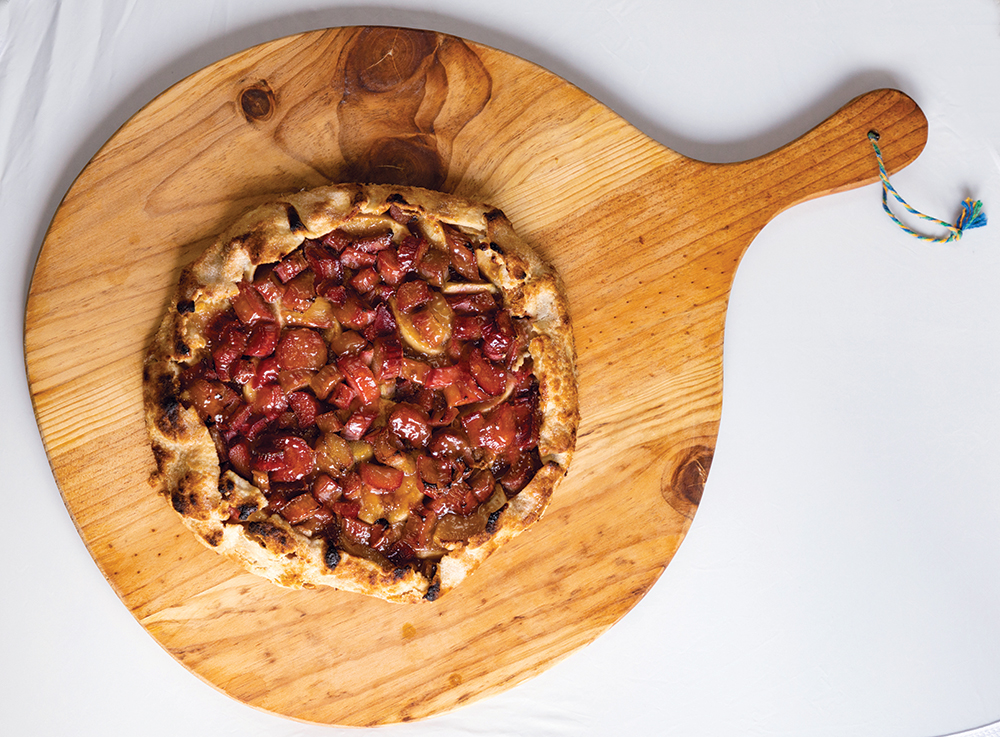I first fell in love with rhubarb as a student in Germany more than 25 years ago. It was truly love-at-first-bite, and ever since has become a part of my yearly spring ritual. Here in the Midwest, where rhubarb thrives in the garden, I’m surprised when I meet people who are unfamiliar with this delicious and versatile plant.
Technically, rhubarb isn’t really a fruit but a “petiole” or stalk that connects the root to the leaf. The plant itself can be quite stunning with its pink and red stalks and large heart-shaped leaves. The leaves, though beautiful, are actually toxic due to the amount of oxalic acid they contain, so don’t be tempted to eat them. When rhubarb is in flower, it shoots up a large white candelabra-like profusion of tiny white blossoms that can be several feet tall. I have it planted in both my vegetable garden and in the front flower border. The stalks of most modern varieties, especially those you see in a grocery store, tend to be a deep red tinged with green. Older varieties that you see in home gardens and farmers markets here in our area are inclined to be mostly green and tinged with pink. I have grown and cooked with both. The flavor is essentially the same, but when cooked the red varieties cook to a more appealing color.
The culinary applications of rhubarb are limited only by your imagination. In its raw state, it is intensely sour and must be tempered by generous amounts of sugar or mellowed by cooking with other ingredients. It can be sliced thin and sprinkled with salt and sugar and “cured” like a little pickle—it turns a brilliant pink. When cooked into a savory-sweet chutney with mustard seeds or other spices and maybe some dried fruits (and sugar), it makes a delicious counterpoint for cheeses or roasted meats. But rhubarb excels in its role as a dessert, be it a pie, crumble, sorbet, cobbler, tart, or syrupy sauce for ice cream. Savory or sweet, enjoy this first local “fruit” in our spring—one not to be missed!

Free-Form Rhubarb and Apple Crostata
One of my favorite spring desserts is a crostata or tart made from apples and rhubarb. The apple helps round out the flavor of the rhubarb and helps keep the tart from becoming soggy (rhubarb can release a surprising amount of liquid when cooked). I think a combination of three firm cooking apples, peeled and sliced, and about one pound of rhubarb stalks, cut into half-inch thick chunks makes a nice balance. Roll out one recipe of your favorite pie crust (or even use a packaged crust from a grocery store) to a large round. Place the crust on a parchment-lined pan and sprinkle it with approximately 1/3 cup of crumbled spicy cookies, like gingersnaps or Italian amaretti. First spread the apples slices in a single layer over the crumbs, using the remaining apple slices to build up a higher outside edge (when folding the crust up over the fruit, the sides of a free-form tart need to be higher to contain the filling and make the tart look more “perky”—and no one really likes the look of a saggy tart). Then cover the apple with the rhubarb chunks. Equitably distribute about ¾ of a cup of sugar over the fruit. Carefully fold the dough up around the edge of the fruit, brush it with melted butter, and sprinkle the rim with a little sugar. Place in a preheated 375-degree oven (if you have a baking stone, place the tart pan directly on it) and bake for approximately 50 minutes, rotating as necessary to ensure even caramelization of the crust. About ten minutes before the crostata is finished, use a pastry brush to dab some of the bubbling juices all over the exposed fruit in the tart. This will give the tart a juicy, delicious, sexy appearance. When the crust is a deep golden brown, the tart is ready. Remove it from the oven and allow it to rest for a minute or two, then slide the tart off of the parchment onto a rack to cool (air circulating under the tart will help insure a crisp bottom crust). Serve slightly warm with your best vanilla ice cream, crème anglaise, or whipped cream.
In Your Pantry

General Usage Techniques: Most dried mushrooms benefit from being rehydrated by pouring boiling water over them (to cover) and allowing them to sit for a few minutes to absorb moisture and release any bits of grit they may have acquired growing out in the forest. When cool, remove from the water and proceed as with fresh mushrooms. There is always a good deal of flavor in the soaking water, so be sure to use that in your recipe or save for soup or stock. Just be mindful of the grit that collects in the bottom of the bowl and discard that.
Porcini/Cepe The umami powerhouse of dried mushrooms, a few slices of dried porcini will add savory depth and richness—umami—to any braises, soups, or stews. Ground into a powder with salt and a hint of crushed red pepper makes a super-secret ingredient dry rub to use on just about anything you would like to roast or grill. Don’t be heavy handed with dried porcini because a little goes a long way—too much can make things taste almost musty.
Morel Try these tasty mor(s)els added to the pan with the vegetables when you cook a roast chicken or duck. As they rehydrate, they absorb the juices and flavors of the bird, adding their own intensely smoky, nutty perfume and earthiness. Rehydrated, use them any way you would a fresh mushroom. Expensive, but worth it.
Shiitake A staple in Asian cuisine, dried shiitake are a convenient and versatile pantry staple that provides umami—plus an interesting texture—to dishes. When rehydrated in a light broth or Japanese dashi with a few spring-onion greens, these little fun guys turn into chewy, almost marshmallow-like, bits. Relatively inexpensive, especially when purchased in larger quantities in Asian markets.
Chanterelle A delicate, fruit-like aromatic quality differentiates chanterelles from other mushrooms, and their deep golden hue is welcome in many dishes. Rehydrate and use for quick and delicious pasta or rice dishes. Especially tasty with bacon and peas. Be sure to slice, and watch the stems—sometimes they can be a little tough after being rehydrated.


